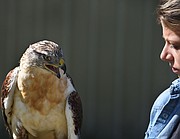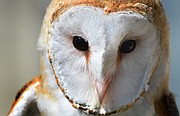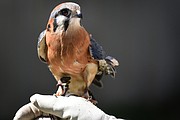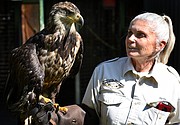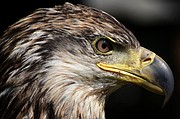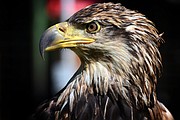Kalispell’s ‘bird lady’ at helm of recovery center
JEREMY WEBER | Hagadone News Network | UPDATED 5 years, 3 months AGO
When Kalispell’s Beth Watne took in her first bird of prey in the early 1980s, she had no idea it would lead to a deep-rooted fascination with raptors. Today, as she runs the nonprofit Montana Wild Wings Recovery Center from her home on the east side of town, Watne helps rehabilitate dozens of injured birds every year while also caring for the two dozen education birds that make the center their home.
“Birds of prey are just fascinating. They each have their own unique personality,” Watne said. “At our education programs, people are always asking me which of our birds is my favorite and my answer is always the one that is on my arm at any given moment.”
Nestled next to her home along the Flathead River just off Panoramic Drive, Montana Wild Wings cares for around 80 to 100 birds each year that are suffering from a variety of injuries ranging from being struck by vehicles to animals that have been shot or poisoned. With the help of more than a dozen volunteers, Watne and the recovery center successfully rehabilitate and release more than 50% of the injured birds back into the wild each year, along with helping flightless birds transition into becoming educational animals.
The center cares for many species of birds, including great horned owls, long-eared owls, barred owls, snowy owls, swainson's hawks, barn owls, peregrine falcons, pygmy owls, saw-whet owls, kestrels, black merlins, red tail hawks, rough legged hawk, cooper’s hawk and more.
While Watne has always had a love for animals, she says her association with birds of prey came completely by accident.
IN THE early 1980s, Watne was using her federal migratory bird permit to raise waterfowl and pheasants as a hobby. When the owner of a golden eagle and a great horned owl in Libby passed away, his widow had no idea how to care for the birds and reached out to the U.S. Fish and Wildlife regional office in Colorado. Knowing that she held a migratory bird license, the regional office reached out to Watne.
She was not interested. It was not until the regional office said the birds might starve without proper care that Watne agreed to take them in. They were her first two raptors and she was quickly hooked.
“Back then, there were not a lot of books on the subject and not a lot of people to talk to for information about how to care for raptors,” she said. “Through talking with others and learning how to handle them, birds of prey really started to interest me.”
Seeing Watne’s success with the two birds, Fish and Wildlife started recommending her for more rehab projects, and in 1983 she founded Wildlife Return, caring for all manner of injured animals, from deer and bears to birds.
AFTER THE decision was made to move the care of the state’s injured mammals to Helena in 2003, Watne continued caring for birds before retiring a few years later and turning the care of her birds over to Lynn Vaught in Whitefish. When Vaught unexpectedly lost her facility in 2012, Watne picked up right where she left off, taking in the birds and founding the Montana Wild Wings Recovery Center.
Everything was moved back to Watne’s house, including the simple chain link cages that housed the birds. Thinking the cages looked “tacky,” Watne’s husband, Bob, set to work upgrading the facility. He built the center’s first building in 2012 before adding a wooden bird habitat in 2013. In 2014, he added another.
With donated materials and volunteer labor, Bob and the Montana Wild Wings crew continued adding on, including a 20-foot-wide, 100-foot-long, 16-foot-tall barn finished in 2019 to help the birds learn how to fly again.
The newest addition, an education center capable of housing groups inside during inclement weather, is set to open later this month.
“If I hadn’t gotten all the help, the donated materials and labor, this place would not be nearly as nice as it is,” Beth said. “I am extremely grateful.”
These days, the center is proud to be in compliance with the numerous federal regulations that govern the rehabilitation of raptors, regulations that specify everything from the size of enclosures to the size and depth of the water bowls available for each species of bird.
THE CENTER is home to nearly two-dozen educational birds of various species, each with their own distinct personalities.
There’s Arthur, the outgoing female ferruginous hawk from a reservation in Eastern Montana who dances on her perch whenever she hears the click of nearby camera shutters taking her picture; and Victory, the sub-adult male bald eagle found with a fractured elbow sitting on a round hay-bale on Danielson Road in Kila in 2017. There’s Spencer, the 18-year-old barred owl; Lacey, the rare calm Osprey; and Tika the snowy owl, among others, each with their own flight-robbing injuries.
While they may never fly again, Beth and her volunteers do everything they can to provide the birds with full and comfortable lives.
“We try to get them outside every day. We all feel bad that they will never be able to fly, but we try to enrich their lives in whatever ways we can,” she said.
WHEN IT comes time to plan an educational program, picking which birds will participate can be a tough task.
“It can be really tough to decide which bird to take to a program because I like them all so much,” Beth said. “Plus, they all like to go to the programs so much and they all deserve to have as much fun as they can.”
Solely dependent on donations from the public, the center has suffered somewhat financially this year as COVID-19 has limited the number of visitors and educational programs, as well as caused the cancellation of the center’s annual fundraising dinner. Despite these setbacks, the center has had another busy year, so far caring for 17 great horned owls, 14 red tailed hawks, 14 bald eagles, nine kestrels and few others.
As the injured birds continue to arrive literally at her doorstep, Beth says she and her volunteers will be there to help.
“I’ve been doing this since 1983 with the same phone number. People see me at programs and all the local vets and law enforcement dispatch know how to get a hold of me,” she said. “I’ve been doing it so long that everyone knows who I am. I can’t go to the grocery store without someone wanting to talk with me about my birds. What can I say? I’m the ‘bird lady.’”
Reporter Jeremy Weber may be reached at 758-4446 or [email protected].
ARTICLES BY JEREMY WEBER

Valkyries three wins from back-to-back state titles
Two years ago, the Bigfork Valkyries came into the season having never won a basketball state championship. Now, they enter the Class A state tournament in Butte this weekend as the favorites to win back-to-back state titles.

Valkyries win third consecutive divisional title
The classification for the Valkyries may be different this season but the result is the same.

Vikings fight to the finish at divisional tourney
The Vikings basketball season came to a close over the weekend as Bigfork fell to Butte Central and Frenchtown at the Western A Divisional tournament in Butte.








